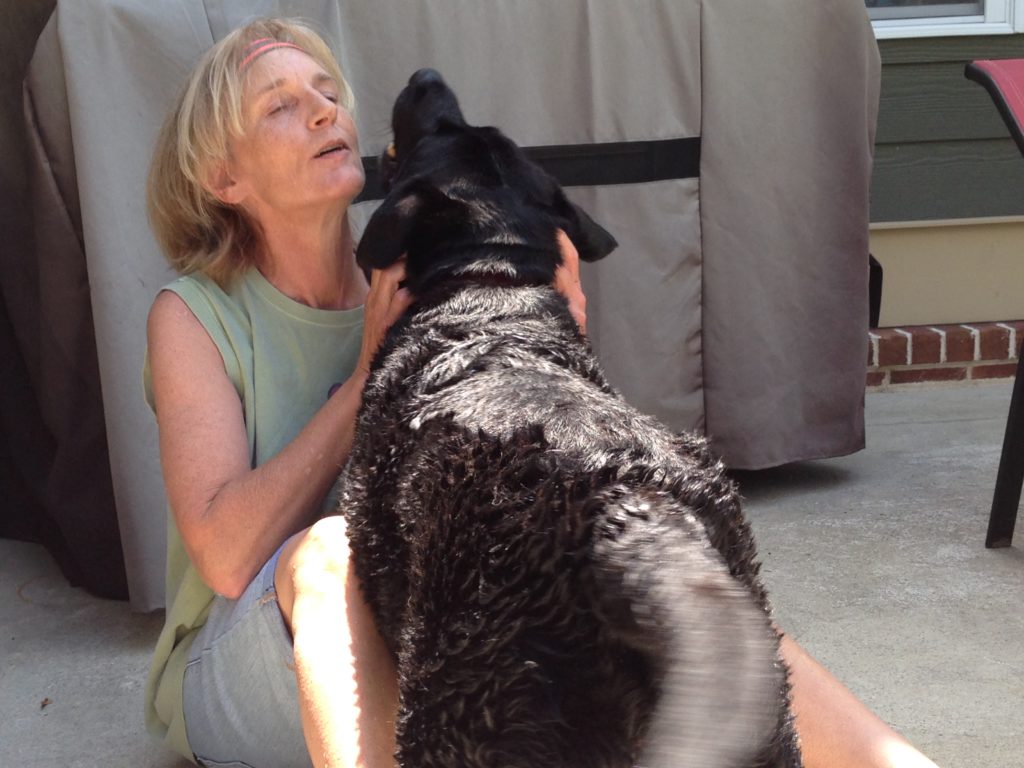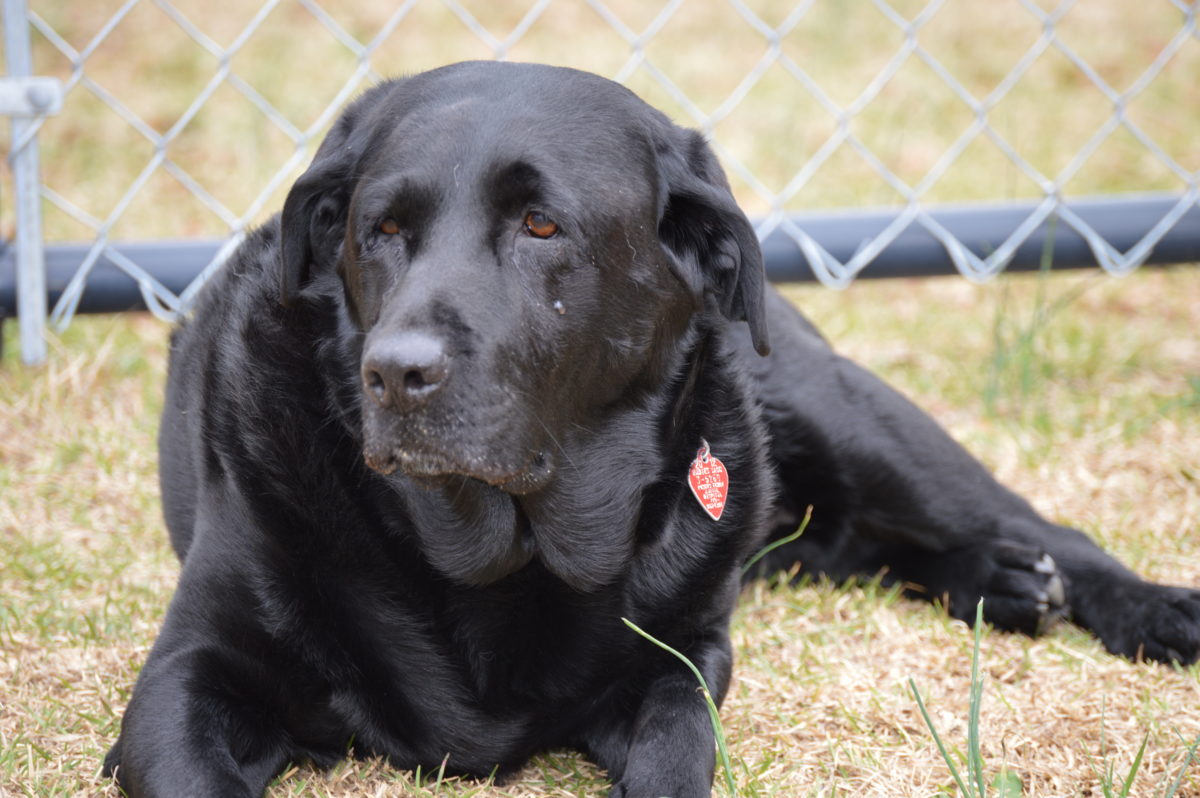I called Story my 100-day dog, her nickname in the final 365 days of her life. By the time she was 12 years old, my black Labrador retriever displayed signs of canine cognitive dysfunction syndrome, and the medication to treat it came in 100-dose bottles. I agreed to a one-bottle trial.
As her dementia worsened, so did episodes of fear, anxiety, and stress (FAS). She got lost in the house and barked at closed doors. Restless at night, she hopped from a raised bed to a four-inch memory foam mattress and back again. Story’s stress was vocal and loud whenever the oven was turned on. (A couple of years prior she had alerted to a fire in the laundry room, and the scent of anything burning set her off like a fire alarm.) I had to physically remove her from the house when we cooked.
Her veterinarian, Matthew Nelson, DVM, prescribed Selegiline, one of the only FDA-approved meds for CCDS, and later added Xanax.
The FAS symptoms, he said, are not universal with old dogs, and Story didn’t show all the major signs. She was still engaged with the family, went on walks with us, and sought us out for comfort when she wasn’t asleep. She crawled into a crate if she felt the younger dogs were too boisterous, so Story was capable of handling some stress without our intervention. She still demanded her meals at the same time each day, and appealed for more with her wide eyes.
Fear and anxiety seem to be more of an individual dog issue, Dr. Nelson said. “We deal with a lot of geriatric dogs, and we see a lot of cognitive dysfunction. I haven’t seen a consistent phase of fear in cognitive dysfunction dogs, although anxiety is certainly common, and the cognitive dysfunction exacerbates it.”
He added, “It’s really critical to rule out other things, like neurological disease, pain, hearing and vision loss, and other medical conditions.”
Story already had regular sessions for acupuncture, laser treatments, massage, and chiropractic care with specialists in canine rehabilitation and pain management. A neurological consult didn’t tell us anything we didn’t know, and I opted out of invasive studies of her brain.
But those moments of fear did appear in January 2019, and we looked not just at medical solutions, but behavioral methods for relief.
Amy Shojai, CABC, advised anticipating and preventing events and situations that lead to FAS. “Setting up and adhering to a familiar routine help enormously to reduce FAS,” she says. She recommends a log to identify fear triggers, then avoiding the trigger, whether loud noises, unexpected movement, or owner absence. “Schedule vacuuming when the dog’s outside,” she says. “Announce yourself before approaching the dog [to] reduce startle reflex, perhaps stamp your feet for the vibration for deaf dogs.
“Wearing a pleasant strong signature scent can help dogs associate the smell with safety. Certain essential oils like lavender and bergamot have a pharmacological effect and act as a natural sedative. Be sure to choose vet-approved essential oil products and use them appropriately,” she says.
Both Shojai and Nelson recommend pheromone products such as Adaptil or Comfort Zone with D.A.P. (dog appeasing pheromone). Mother dogs produce this when puppies nurse, which helps keep them calm. It may also help reduce anxiety in older dogs.
Dr. Nelson says diets and supplements such as L-theanine, Colostrum Calming complex, and thiamine, or vitamin B1, may help. “I’ve used SAM-E [Denamarin], too, but it’s not been proven to help. The ingredients in Composure and Solliquin have been shown in studies to be anxiolytic, and I think they help in mild to moderate cases” of FAS, he says. A dietary supplement called Senilife can also help maintain a dog’s brain function. Veterinarians can prescribe special diets to help manage brain-aging disorders. Foods such as Neurocare from Purina and b/d from Science Diet are backed by research to help support brain health.
Shojai is a big fan of music therapy, as it is noninvasive and easy to use. “Music that has a slow, steady beat helps calm pets by entraining the brain waves and heart rhythms.”
Story would let use know if our music was too loud at home, so we adjusted the volume. In the car I played soft music instead of speaker-pounding rock.
Story received significant help from Selegiline. We had to play around with the timing of the dose; because the medication is a stimulant, she initially did better when medicated in the morning. Later we changed her dose to the afternoon, which kept her awake and active longer into the evening, so her nighttime walk-abouts in the dark house lessened. We all slept better for a while.
Story got through three full bottles, then a quantity of 30, when the helpful effects just stopped. Once off the Selegiline, Story seemed better, though. We took advantage of our springtime, with its glorious bursts of color, scents to track in our fields, sticks to carry, holes to be dug, dirt and grass and other inappropriate items to be eaten.

She was herself, again, until a day in May when she was not, and she let me know early that morning. She was a month shy of turning 14, and her body was slow and tired and hurting. The only fear that day was mine.
This article was reviewed/edited by board-certified veterinary behaviorist Dr. Kenneth Martin and/or veterinary technician specialist in behavior Debbie Martin, LVT.








